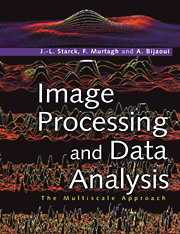Book contents
- Frontmatter
- Contents
- Preface
- 1 The wavelet transform
- 2 Multiresolution support and filtering
- 3 Deconvolution
- 4 1D signals and Euclidean data analysis
- 5 Geometric registration
- 6 Disparity analysis in remote sensing
- 7 Image compression
- 8 Object detection and point clustering
- 9 Multiscale vision models
- APPENDIX A Variance stabilization
- APPENDIX B Software information
- APPENDIX C Acronyms
- Bibliography
- Index
7 - Image compression
Published online by Cambridge University Press: 30 October 2009
- Frontmatter
- Contents
- Preface
- 1 The wavelet transform
- 2 Multiresolution support and filtering
- 3 Deconvolution
- 4 1D signals and Euclidean data analysis
- 5 Geometric registration
- 6 Disparity analysis in remote sensing
- 7 Image compression
- 8 Object detection and point clustering
- 9 Multiscale vision models
- APPENDIX A Variance stabilization
- APPENDIX B Software information
- APPENDIX C Acronyms
- Bibliography
- Index
Summary
Image compression is required for preview functionality in large image databases (e.g. Hubble Space Telescope archive); with interactive sky atlases, linking image and catalog information (e.g. Aladin, Strasbourg Observatory); and for image data transmission, where more global views are communicated to the user, followed by more detail if desired.
Subject to an appropriate noise model, much of what is discussed in this chapter relates to faithful reproducibility of faint and sharp features in images from any field (astronomical, medical, etc.)
Textual compression (e.g. Lempel-Ziv, available in the Unix compress command) differs from image compression. In astronomy, the following methods and implementations have wide currency:
hcompress (White, Postman and Lattanzi, 1992). This method is most similar in spirit to the approach described in this chapter, and some comparisons are shown below, hcompress uses a Haar wavelet transform approach, whereas we argue below for a nonwavelet (multiscale) approach.
FITSPRESS (Press, 1992; Press et al., 1992) is based on the non-isotropic Daubechies wavelet transform, and truncation of wavelet coefficients. The approach described below uses an isotropic multiresolution transform.
COMPFITS (Véran and Wright, 1994), relies on an image decomposition by bit-plane. Low-order, i.e. noisy, bit-planes may then be suppressed. Any effective lossless compression method can be used on the high-order bit-planes.
JPEG (Hung, 1993), although found to provide photometric and astrometric results of high quality (Dubaj, 1994), is not currently well-adapted for astronomical input images.
Information
- Type
- Chapter
- Information
- Image Processing and Data AnalysisThe Multiscale Approach, pp. 217 - 230Publisher: Cambridge University PressPrint publication year: 1998
Accessibility standard: Unknown
Why this information is here
This section outlines the accessibility features of this content - including support for screen readers, full keyboard navigation and high-contrast display options. This may not be relevant for you.Accessibility Information
- 4
- Cited by
